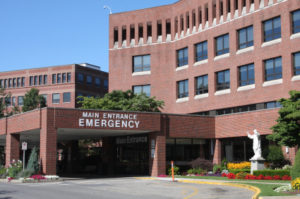Health Care Lobbying Rose in 2018
 Hospitals and health systems spent $99.7 million lobbying in Washington, D.C. last year, just barely more than in 2017 but much less than in 2009, when the focus of health care lobbying was the Affordable Care Act, then just a proposal and not a law.
Hospitals and health systems spent $99.7 million lobbying in Washington, D.C. last year, just barely more than in 2017 but much less than in 2009, when the focus of health care lobbying was the Affordable Care Act, then just a proposal and not a law.
The issues on which they spent the most money lobbying were the 340B program, site-neutral Medicare payments for outpatient services, safety-net hospitals, Medicare-for-all proposals, and Medicaid funding.
Learn more about what hospitals spent their lobbying money on, who were the biggest lobbying spenders, and where industry groups figure in the overall spending in the Healthcare Dive article “Hospital lobbying in 2018 — by the numbers.”
 According to a presentation delivered at a MACPAC meeting last week:
According to a presentation delivered at a MACPAC meeting last week: SNAP’s letter addressed three aspects of the proposed regulation: payment rate ranges, directed Medicaid payments, and Medicaid pass-through payments. The overall theme underlying SNAP’s comments was that the proposed changes represent positive steps but could be taken further to provide additional flexibility for Pennsylvania’s Medicaid program to take stronger steps to ensure the ability of Pennsylvania safety-net hospitals to serve their communities.
SNAP’s letter addressed three aspects of the proposed regulation: payment rate ranges, directed Medicaid payments, and Medicaid pass-through payments. The overall theme underlying SNAP’s comments was that the proposed changes represent positive steps but could be taken further to provide additional flexibility for Pennsylvania’s Medicaid program to take stronger steps to ensure the ability of Pennsylvania safety-net hospitals to serve their communities. The uninsured do not use emergency rooms more than the insured.
The uninsured do not use emergency rooms more than the insured. The site, a collaboration between the state’s Human Services and Aging departments, lists services in 12 categories: advocacy, behavioral health, employment, finance, health care, housing, in-home services, legal, meals, protection from abuse, support groups, and transportation. It also provides information to and links about programs, organizations, and services.
The site, a collaboration between the state’s Human Services and Aging departments, lists services in 12 categories: advocacy, behavioral health, employment, finance, health care, housing, in-home services, legal, meals, protection from abuse, support groups, and transportation. It also provides information to and links about programs, organizations, and services. Diabetes admissions in Pennsylvania resulted in $205 million in payments to hospitals in 2016, but according to the Pennsylvania Health Care Cost Containment Council, about 86 percent of 2016 adult admissions could have been prevented with more timely and appropriate care and disease management.
Diabetes admissions in Pennsylvania resulted in $205 million in payments to hospitals in 2016, but according to the Pennsylvania Health Care Cost Containment Council, about 86 percent of 2016 adult admissions could have been prevented with more timely and appropriate care and disease management. Community HealthChoices is a new state program of managed long-term services and supports for Pennsylvanians over the age of 55 who are eligible for both Medicare and Medicaid.
Community HealthChoices is a new state program of managed long-term services and supports for Pennsylvanians over the age of 55 who are eligible for both Medicare and Medicaid.